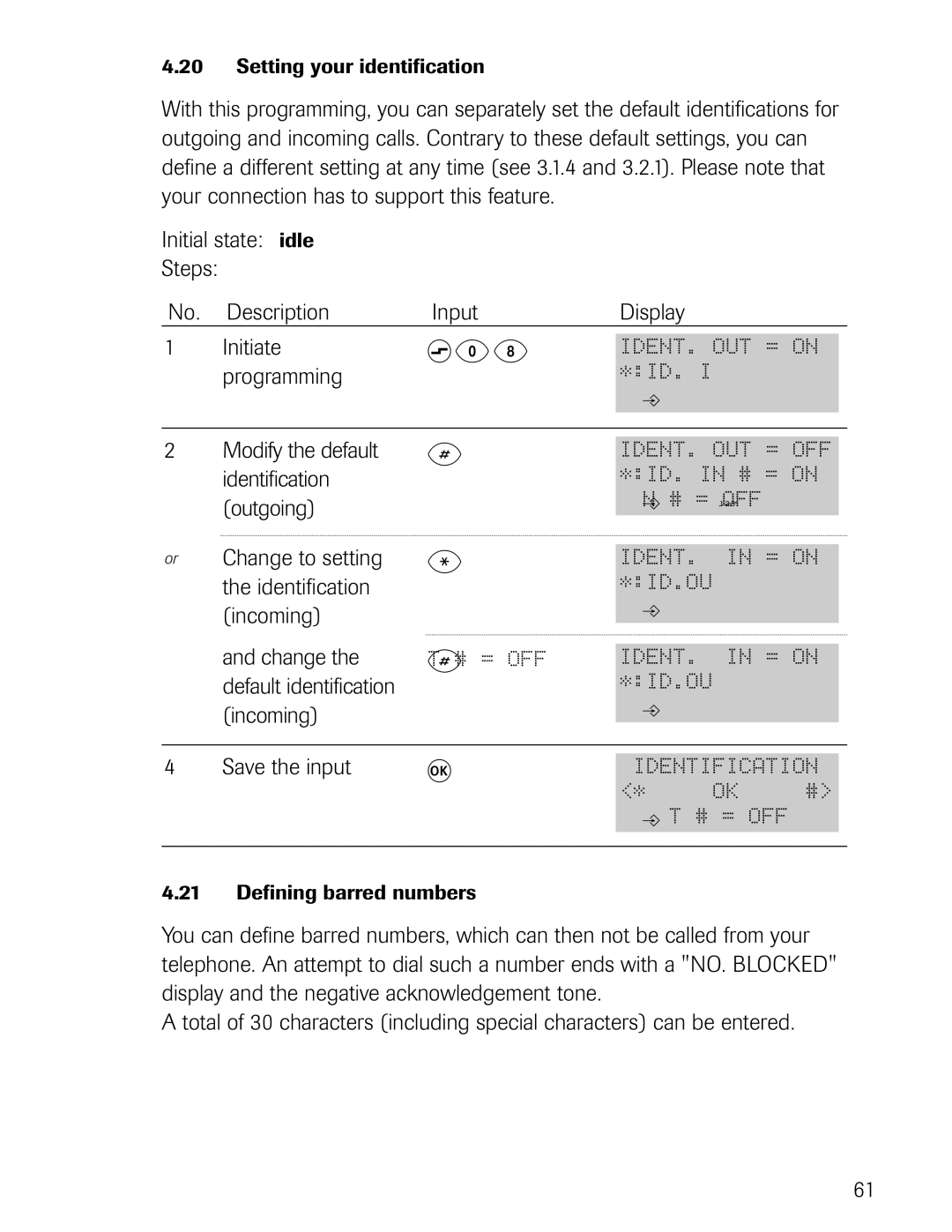SmartLine D711
Contents
Programming
Emergency operation switch An emergency
SmartLine D721 only
Appendix
Isdn telephone
Introduction
Easy-to-operate high-convenience
Nection of an analog terminal
General
4712
For the analog port
4711
4713
Scope of delivery
Shift key Change function level
Call diversion set up
Ok key
Connector for Adapter cable SmartLine D721 only
Start up
Establishing and undoing a plugged connection
Description Input Moving the cursor
666 8#
± or ‘
Clears the complete line
Dial tone
Telephoning
Chaining telephone numbers Direct call
Further functions
Free operation
With the handset
On-hook hands
If necessary, change s MSN ˜1…8·§ the MSN see
Use a stored num
Ber see
Dial telephone
Chain numbers
See
Number
If previously off
Steps Description Input Display Number
Presentation on
Presentation off
Edit
Press funtil
Displayed Confirm selection
Telephone number
±/‘
Memory
Key, on-hook
Key, number is
Dialled
Steps Description Input Display
On/off temporarily
Ringing tone for
Business call
Number also from
Business call
W, Z
Play further entries
Displaying the first Most recent entry Call for MSN
If necessary, dis
End the first con
Steps Description Input Display Place the first con
Nection on hold
Nection and accept
Ringing sounds
Scroll to Or #
Description Input Display Display first
Callback
Required entry Confirm clearing Positive ac
Activate malicious Sfpositive ac
Caller identification
Steps Description Input Display Lift the handset
Levels
Alter the volume Several times
Cally and you hear Dial tone
Is stored
Resume
Exchange
End the hold state
Conversation
Altered in nine steps Several times to
Volume can be
Dtmf digits Keypad signals
Store the modified
Select the MSN
Function during a
Edit digits clear Or enter
Store
Code
Description Input Display Park a call
Enter the two-digit
Confirm
Entering a number
Memory Only during Call
To clear the current t 345678 connection, press
Placing a callers telephone number in the redial memory
Steps Description Input Display Switch the call
Divert calls
Programming
Which you wish to
Mode
Diversion is offered
MSN display for each
Input Display Adjust display con If nec. sev
Trast in 11 levels Times
Quit display Or o, after Last MSN has Been displayed
Normal and loud
Steps Description Input Display Switch handset
Volume between
Lock on or off
Settings as
Described above
00.00.99/0000
D721Unchangedonly Off Handset volume Normal
Programming
Prefix, national Prefix, international No entry Redial
Overview of programmable functions
S006
Ror sR
S04
On and off
Next call diversion
Is offered
S01
Switch over
S005
Or the complete
Identification
Enter the date and Z
Time
Language
S008
Select the required
Ring the call charge counter and defining the factor
S06
Confirm reset
S009
Prefix code
S000
S002
If nec. Clear digits singly R or sR
S09
Enter or edit the number
Private or
S91…8
S001
If nec. Clear digits singly Ror sR
Last digit
Define ranges by Entering a dash
S004
Enter a blank as a Delimiter between Several schemes
Code, up to 6 digits
S007
Enter the local area
Prefix without
Enter the new PIN
S03
Enter the old PIN
Incoming
Default identification
S08
01901 to
S07
Or sR
If nec. Clear digits
S0b
Saved
Number input, save
Entry
Move the cursor
…9, *, #
S9 1…8
Saved
Description Input Display Initiate
Setting can be # switched over be- tween on and off
S02
Memories
Emergency operation
Analog port SmartLine D721 only
…2 Not used …6 Not used
MSN entry Ringing Tone
SmartLine D721 On the analog port
MSN entry Ringing
Terminal
Users number
Steps Description Input Initiate consultation
Dial the internal
No. Description Input Pick up ringing or
Depending on
During a conversation 1.1 Pic
Steps Description
Second one Put the first connection R Depending on
Has been activated Otherwise negative
37#
Activating automatic callback on busy
#43#
#37#
43#
#21
#61
Repeat the new New Confirm it by
#67#
Old Enter the new New Confirm it by
Code *1# Apply the Isdn
#33
Description Input Display Select the full lock
Check lock
Without dialling Input within
#53#
Without dialling Destination No. # Check connection
Seconds after Lifting the handset
Appendix
73/23/EEC Low-voltage Guideline
700 Ohm
When using pulse dialling
Key Flash 50 ms … 350 ms Ringing voltage
S04 S05 S06 S07
S09 S00 S001
Resetting the unit Reset Programming call pick up D721 only
S002 S004 S005 S006 S007 S008 S009 S000 S0b S0w S0r
Example configuration Number identification
Conference 29, 38 Connecting
Editing mode
Accepting 53, 70
Ringing tone Switching
Plug-in connection Power failure
Redial memory 20, 34, 37 Reset
Tone ringing Tones Volume
Page
Page
Postbus
PB Eindhoven Edition 11/99

